

Mauritius is a true volcanic island, approximately 8 million years old. It is the main island and center of life of the Republic of Mauritius, a maritime nation located in the Indian Ocean, approximately 2,000 kilometers off the southeast coast of Africa.
General characteristics:
- The island covers an area of 1,864.8 square kilometers and is home to approximately 1,300,000 people.
- The capital and largest city is Port Louis.
- In addition to the main island, the Republic of Mauritius includes 5 outer islands and about 49 small uninhabited islets.
- Time zone: GMT +4.
Mauritius was once a stopover for Arab and Portuguese sailors, then a refuge for pirates who attacked British merchant ships. Today, the island displays a blend of Dutch, French, and British colonial influences, reflected in its architecture, culture, and cuisine.

Depositphotos
Interesting facts about Mauritius
- The island has no official language. Many speak English or French. There is also a distinct local dialect: Mauritian Creole.
- Most of the inhabitants are of South Asian origin.
- Almost half of the population are Hindus, 30% are Christians (most of them Catholics), 16% are Muslims.
- You can even cross Mauritius on foot. You can walk from north to south in just one day. It's 65 kilometers long and 50 kilometers wide.
- Most of the tourists are French, and the supermarkets are stocked with French cheeses and delicacies.
- Half of the country's total area is covered by sugar cane plantations.

Depositphotos
Natural Wonders of Mauritius
The island's coastline is lined with more than 150 kilometers of white sandy beaches, which, along with mountains, plateaus, gorges, and waterfalls, create a true natural treasure trove for naturalists and photographers.
Among Mauritius' most famous natural attractions is the Chamarel Falls, a cascade of water cascading from a high cliff into the crater of an ancient volcano. Here you can also see the Chamarel Colored Sands—seven multicolored shades of earth formed by volcanic rocks and minerals, creating a stunning rainbow effect right on the shore.
The island's flora and fauna are strikingly diverse: it is famous for its giant tortoises, rare birds, and unique plants, the subject of legends dating back to the time of the extinct dodo. Numerous nature reserves and parks allow tourists to immerse themselves in the island's tropical world, which preserves parts of its pristine ecosystem.

Depositphotos
When to fly to Mauritius: climate and best season
It's a comfortable place to relax at almost any time of year – the constant tropical maritime climate makes a trip a success even in the hottest months. In summer, from November to April, the air temperature rises to 33°C, and the sea enjoys a warm 25-28°C, providing ideal conditions for swimming, snorkeling, and water activities.
Winter in Mauritius, from May to October, is mild: daytime highs reach 20–25°C, with nighttime temperatures dropping to 15°C. The northern and western coasts of the island experience drier and calmer weather, while strong winds are common in the south and east. The transitional months of April and May are considered ideal for tourists: the summer heat has subsided, and the monsoons and rains have yet to arrive.
With its warm ocean and moderate humidity, Mauritius is ideal for beach holidays, romantic photo shoots, and active tourism.
Whatever time of year you choose to vacation in Mauritius, be prepared for short but intense downpours, especially on the east coast. But even if the rain catches you unexpectedly, it quickly gives way to sunshine, and the island's natural beauty reveals itself in a new light: the green hills, waterfalls, and coral reefs seem even more vibrant.

Depositphotos
Where to relax in Mauritius: coasts, cities and regions
Your choice of accommodation in Mauritius directly impacts your travel expectations. The island impresses with its diverse natural landscapes: from tranquil western bays to windy eastern beaches, from verdant mountain plateaus to picturesque coastal towns.
- The northern coast is the heart of tourism. It's home to the largest cities and resorts, including the famous Grand Baie. The north is renowned for its restaurants, cafes, shops, and nightlife. Shopping enthusiasts and outdoor enthusiasts will find everything they need here. The capital, Port Louis, is also located here, where you can stroll through its markets, botanical garden, and waterfront.
- The west coast is ideal for romance. The beaches of Flic-en-Flac and Tamarin are known for their calm waters and picturesque views. Here, you can enjoy a safari in Casela Natural Park, observe wildlife, or take a tour of the multicolored sands and Chamarel Waterfall.
- The east coast is quieter and more authentic. The tourist infrastructure here is more modest, but the sunrises over the Indian Ocean are stunningly beautiful. These places are perfect for those seeking tranquility, sea breezes, and an encounter with authentic island culture.
- The southern coast is considered windier and cooler. It's less crowded, but offers more wildlife and pristine beaches. It's a great destination for ecotourism and active recreation enthusiasts.
- The central part of the island is home to local residents. It's home to small towns, tea plantations, and trekking trails. Central Mauritius is a destination for those who want to experience authentic island life, escape the tourist crowds, and enjoy nature.
The choice of coastline determines not only the weather and wind conditions, but also the type of vacation. For a relaxing beach holiday, it's best to choose the north or west, while for exploring culture and nature, the center or east.

Depositphotos
Things to do in Mauritius
Mauritius offers tourists a truly unforgettable experience, thanks to its highly developed entertainment infrastructure. Here are a few reasons why the island should be on your must-visit list:
- Diving. The most popular activity on the island, surrounded by a coral reef. The underwater world here is truly magical.
- Ocean floor walks. A special helmet with air, weights, and you're walking along the ocean floor.
- Underwater scooters. Dive almost to the ocean floor. A sea of excitement and thrills are guaranteed.
- Submarine. A true adventure at depths of up to 35 meters: coral gardens, a sunken ship, and even champagne on the ocean floor for special occasions.
- Sea excursions. Catamarans will take you to the picturesque islands surrounding Mauritius.
- A helicopter flight over the island lasts from 15 minutes to an hour – the best way to see all of Mauritius and the famous "underwater waterfall." A seaplane is an alternative.
- Skydiving. A tandem parachute jump with an instructor and a minute of freefall – maximum adrenaline and panoramic views.
- Water Sports. Kitesurfing and windsurfing are among the main water sports in Mauritius. The best time is September-November for kitesurfing and May-September for windsurfing.
- Trekking. Mauritius is ideal for trekking. Popular routes include Le Morne Gorge, Tamarin Falls, and the crater of an extinct volcano.
- A glass-bottom boat is a budget-friendly way to see the underwater world.
- Zipline. In the south of the island, you can fly over rivers and lush jungle—an unforgettable view and an adrenaline rush.
- Golf. One of the most popular recreational activities: the courses here are picturesque, well-maintained, and overlook the ocean. Mauritius's luxury golf hotels are worthy of special attention.
- Horseback riding. You can go to the racetrack, place a bet, or simply ride along the coast.
- Fishing. People come from all over the world for blue marlin, tuna, and barracuda. The best catches are found behind the reef, where fishing becomes a true adventure.
- Rum distilleries. The best excursions on the island always end with tastings of legendary Mauritian rum.
Mauritius also boasts playful dolphins, ancient estates of former colonizers, tea and pineapple plantations, and captivating photo ops on the ocean shore.

Depositphotos
The underwater world of Mauritius
Diving deserves special mention. Among all the island's attractions, the rich and colorful underwater world stands out. Mauritius is surrounded by a coral reef, considered the third largest in the world, which serves as a living shield for the lagoon from the waves.
In fact, the coral shoals around the island form a belt structure covering more than 240 kilometers, home to approximately 110 species of corals and over 130 species of fish. Thanks to this reef, the water in the lagoons remains clear, calm, and ideal for diving and snorkeling year-round.
Divers consider Mauritius a true mecca: giant turtles, colorful fish and shipwrecks create a spectacular underwater scene.

Depositphotos
Cities of Mauritius
- The capital of Mauritius is Port Louis. Every tourist must visit the bustling and colorful market, where aromatic spices and freshly caught fish are sold.
- Rose Hill is more of a student town, home to the island's only university. All the buildings are built in the colonial style.
- Curepipe is a wonderful place with lots of shops.
- Mahebourg is a historic town where the ancient castle of Château Robillard has been preserved .
- The town of Moka. You can see a former sugar factory and amazing colonial-era architecture.

Depositphotos
Attractions in Mauritius
This relatively small island offers numerous sights worth seeing with your own eyes. A tour will require at least 3-5 days.
- The extinct volcano Trou aux Cerfs. The volcano's crater is 300 meters wide and is one of the most popular excursion sites.
- Deer Island is known for its beaches with crystal-clear waters. It was once home to a large deer population.
- The Black River Gorge is home to a vast park with rare plants and unique birds, as well as Turtle Bay, a major tourist attraction.
- The colored sands of Chamarel. The best time to admire the multicolored sands is morning or evening. At other times, you'll be disappointed by the dull colors. You can buy flasks of colored sand and see for yourself: even if you shake the sand, the grains will still settle and clearly separate into seven colors.
- Chamarel Falls is the island's signature feature. It plunges 100 meters into the crater of an extinct volcano.
- La Vanille Park is a popular destination for tourists looking to take photos with giant tortoises, cute lemurs, and terrifying alligators. You can walk with them, touch them, and even feed them.
- The underwater waterfall is an anomaly formed by the unique arrangement of coral reefs. Viewed from above, it creates the illusion of a real waterfall.
- The Pamplemousses Botanical Garden is the largest and oldest in the Southern Hemisphere. It is here that giant lilies bloom, resembling enormous frying pans.

Depositphotos
Mauritian cuisine
Local culinary traditions blend Chinese, European, Indian, and Creole cultures. This mix gives Mauritian cuisine a striking diversity of flavors and aromas. Its mainstay is curry, in its many variations. Almost every dish is generously seasoned with spices, often quite spicy. Must-try dishes include the "millionaires' salad" made from hearts of palm, smoked marlin, and, of course, the freshest seafood, so generously provided by the Indian Ocean.

Depositphotos
How to get to Mauritius
Not every country offers flights to this tropical island. Hubs offering this option include Paris, London, Rome, Milan, Frankfurt, and Dubai. Flights arrive at Sir Seewoosagur Ramgoolam International Airport, located 25 kilometers from Port Louis.

Ashim D’Silva
Getting Around Mauritius: How to Explore the Island
Mauritius is relatively small, but it offers a surprising diversity of landscapes: from sandy beaches and coral reefs to mountain trails and waterfalls. To see it all, it's important to plan your transportation.
- By car. Roads in Mauritius are generally good, but keep in mind that drivers drive on the left side of the road, and the switchbacks can be narrow and winding. Renting a car starts at $20 per day, while a car with a driver costs around $150. A liter of gasoline costs around $1.20. Independent travel is convenient and relatively inexpensive.
- Public transportation. A well-developed bus network connects major cities and tourist centers. There are approximately 220 routes on the island. Fares start at $0.85, and buses operate from 5 a.m. to 7 p.m.
- Taxis and transfers are a convenient option for short trips. Transfers within a city typically cost $10-20, but it's important to negotiate the price in advance.
- Scooters and bicycles are a popular way to take short trips around coastal resort areas.

Depositphotos
Currency and prices in Mauritius
The official currency is the Mauritian rupee. 100 rupees are equivalent to approximately $2.18. You can exchange money at the airport, banks, hotels, city exchange offices, and even in stores if you have dollars or euros. Keep in mind that banks are closed in the evening until 3:30 PM. Some branches only open until 11:00 AM.
ATM withdrawal fee is Rs 200 plus double conversion is possible.
Approximate expenses during the week:
- Car rental - not less than $150.
- A room in a 4-star hotel for two is $1700.
- Mobile connection: 5 GB - $12-15.
- Food costs: from $7 for lunch in an inexpensive cafe and from $40 for two for dinner in a restaurant.

Depositphotos
Visa regulations in Mauritius
Citizens of most countries do not require a visa to visit Mauritius. A permit stamp is issued upon arrival free of charge and is valid for up to 60 days for citizens of Europe, the United States, Canada, and Australia. Citizens of countries such as Afghanistan, Bangladesh, Iran, Iraq, North Korea, Laos, Mali, Pakistan, Somalia, Sudan, Syria, and Yemen must obtain a visa in advance to visit Mauritius.
You must have a return ticket, hotel reservation confirmation, medical insurance and proof of sufficient funds (approximately $100 per day), otherwise you may encounter problems when crossing the border.

Depositphotos
What can and cannot be imported into Mauritius
Allowed import:
- up to 200 cigarettes or 250 g of tobacco.
- 1 liter of strong alcohol or 2 liters of beer/wine.
- 100 ml of perfume or 250 ml of eau de toilette.
- Personal equipment.
Prohibited: meat products, sugar cane, narcotics, underwater hunting equipment, electronic cigarettes, products and fruits from East/Southeast Asia and Africa.
The export of cash without declaration is limited to amounts up to $10,000.

Depositphotos
Accommodation in Mauritius
Mauritius offers a wide range of accommodation options, from 5-star hotels and beachfront resorts to small apartments in quiet corners of the island. The choice of accommodation depends directly on your budget and the purpose of your trip.
- 5-star hotels in Mauritius are the choice for those seeking maximum comfort and service. The coastline is home to prestigious hotels like the LUX* Grand Gaube , with swimming pools, spas, restaurants, and a private beach area. Rooms start at $200 per night.
- Four-star hotels in Mauritius are the best option for a comfortable vacation on a budget, starting from $100 per night. For example, Zilwa Attitude on the north coast offers cozy rooms, a variety of restaurants and pools, and a convenient location for exploring the surrounding area.
- Private accommodations and apartments – for budget vacations and extended stays. Apartments start at $20 per night.
It's important to consider seasonality: during peak months, particularly the Christmas holidays, hotel and apartment prices can be significantly higher, and the best places are best booked in advance.
Mauritius is a place where everyone can find something for themselves: from a relaxing beach holiday to active adventures in the mountains and underwater. The local cuisine, colorful cities, and stunning tropical nature make the island vibrant and memorable.

Zilwa Attitude
More articles
- Best Bali Hotels Adults Only
- The best hotels in Bali for family holidays
- The best family hotels in Seychelles
- Java Island on your own - where to go and the main tips
- Top 5 Sustainable Tourism Destinations in Indonesia
- Holidays in Bali: top 22 things to do on the island
- Nyepi in Bali - New Year or Day of Silence
- Rains in Bali: pros and cons of the wet season
- Hotels of Ayana complex in Bali
- Gunung Batur: how to get to the main volcano in Bali



